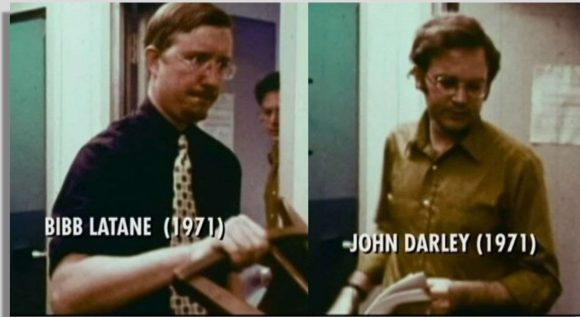The March 13, 1964 murder of Kitty Genovese led to an entirely new field of research in psychology. Genovese was attacked while walking home from work at 3:20 a.m. in Queens, New York. She was stabbed, sexually assaulted, and murdered over a period of 30 minutes. Subsequent reports said 38 witnesses watched the attack from nearby apartments but neither intervened nor even called the police until the attacker fled. Kitty Genovese died on the way to a hospital.
Two psychologists, Bibb Latané and John Darley, conducted extensive research to examine and try to explain such apparently callous indifference to the suffering of another human being. Over time, these and other researchers teased out several factors that will affect the likelihood of bystander intervention.
- Diffusion of responsibility is one of the earliest and most powerful variables identified: the more people who are bystanding, the less likely it is that anyone will intervene. Responsibility is diffused among all.
- Contrarily, Philpot et al. just this year published the results examining real-life video recordings from three countries and found that someone intervened in over 90% of cases. Even if the likelihood of any one person responding was infrequent, someone in the crowd intervened.
- Emergency vs. non-emergency situations. The following conditions are relevant.
- Notice that something is going on.
- interpret the situation as an emergency. Others not reacting provides social influence against acting,
- Feel responsible: does the victim deserve help, is the bystander competent, what is the bystander’s relationship to victim.
- The form of assistance needed (e.g., medical emergency, harassment protection, etc.).
- Implement the action choice.

- Ambiguity and consequences: ambiguous situations take up to five times as long to respond to, and even then bystanders will often not intervene until after assessing their own safety.
- Cohesiveness and group membership: the more cohesive a group, the more likely it is that the norm of social responsibility will lead to helping. Bigger cohesive groups are quickest to react.
- Cultural differences affect intervention—both broad/national culture and subculture.

- Digital interference is a relatively new phenomenon. With the spread of cell phones and social media, bystanders at a scene are becoming more likely to try to film the incident (whether as “armchair activism” or simply to attract online attention) than they are to intervene or call for help. This has the doubled impact of overloading nearby cell towers so that actual phone calls to emergency services are not connected.

Bystander apathy can be counteracted by raising awareness of bystander effects ad consciously taking steps to overcome it and help; and victims can overcome the diffusion of responsibility in groups by singling out a single member and asking for help from that one person.

Bottom line for writers: make your readers understand why your character does or does not intervene!







